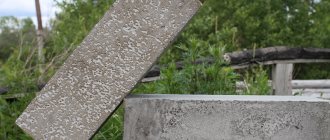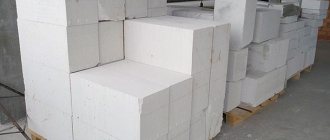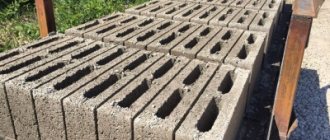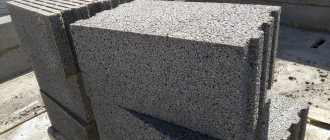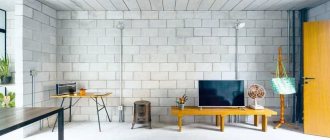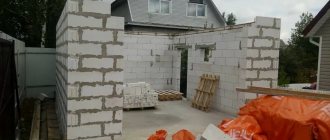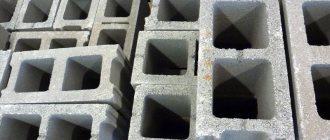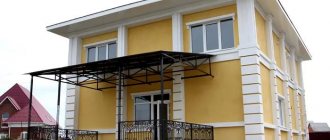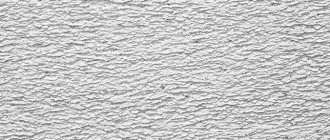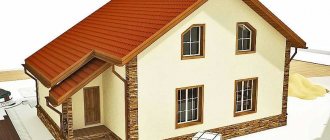The desire to combine completely different properties in one material is the driving force of modern construction science.
She made cold and heavy, but durable concrete light and warm by introducing into its structure a polymer foamed in the form of granular balls.
The new material is called polystyrene concrete. The first mention of it dates back to the middle of the last century, when the German chemical concern BASF developed the technology for its production.
Later, in the USSR, research was also carried out on the physical and mechanical properties of cement stone with polystyrene foam filler.
However, this material has not become widespread in housing construction, although in 1973 a special GOST R 51263–99 was developed for it.
Today, the production of polystyrene concrete is organized on an industrial scale and many developers choose it. In order to understand how beneficial the use of polystyrene concrete is in individual housing construction, it is necessary to study its properties in more detail.
Main characteristics
First, let's look at the physical and mechanical properties of polystyrene concrete, standardized by GOST:
- The density of the material ranges from 150 to 800 kg/m3;
- Frost resistance ranges from F35 to F300 (from 30 to 150 freeze-thaw cycles);
- Compressive strength ranges from B0.35 - B2.5 (grade M5 - M35);
- Thermal conductivity coefficient: minimum 0.055 W/mC, maximum 0.145 W/mC;
- Vapor permeability is 0.05 mg/(m h Pa);
- Flammability group G1 (non-flammable material).
At first glance, it seems that the “construction passport” of polystyrene foam is normal, and it is optimally suited for the construction of walls. However, some physical parameters are questionable. The compressive strength of this material is not high (maximum M35), so buildings with a height of more than 2 floors should not be built from it.
The low vapor permeability of polystyrene concrete has its pros and cons. Blocks made from it practically do not absorb water, so they resist temperature transitions well beyond 0 degrees. It is for this reason that the frost resistance of this material is very high. But a wall made of polystyrene foam will not breathe, because it is very difficult for water vapor to pass through it.
Environmental friendliness is another stumbling block that confuses those who would like to use expanded polystyrene concrete. We will not repeat the arguments of supporters and opponents of this material, but note for ourselves that the truth can only be established after many years of research. Only by using a sensitive gas analyzer to monitor the level of styrene in the air can a reasoned conclusion be made about the toxicity or safety of polystyrene foam blocks. Unfortunately, no one has made such observations.
Hygienic certificates issued by laboratories for blocks made of polystyrene foam confirm its environmental safety. Without a serious evidence base, we have no reason to argue with them.
Density is the main factor that determines the scope of application of this material. According to the accepted gradation of volumetric weight, concrete with the addition of polystyrene foam is no different from other types of building blocks.
The first group includes polystyrene concrete blocks with a volumetric weight of 150 to 300 kg/m3. They are used exclusively for external cladding of buildings and for laying internal non-load-bearing partitions.
The second group is structural and thermal insulation blocks with a density from 350 to 500 kg/m3. Used for laying internal load-bearing walls.
The third group is represented by polystyrene concrete with a density of more than 500 kg/m3. This material is called structural. It is suitable for the construction of external walls of low-rise buildings (up to 2 floors).
DIY polystyrene concrete
This building material can be prepared no more complicated than a cinder block. To prepare polystyrene blocks you will need:
- Concrete mixer.
- Crushed polystyrene.
- Cement.
- Sand.
- Water.
You can try to make polystyrene foam with densities D350 and D1200 with your own hands. In this case, the second composition is needed for the preparation of load-bearing structures, and the first is suitable for creating heat-insulating material.
Expanded polystyrene D1200 contains:
- 1.1 m3 of expanded polystyrene crumbs,
- 300 kg of cement,
- 800 kg of sand.
After hardening of the material, a fairly monolithic and strong block of lightweight concrete is obtained.
D350 has the same volume of cement and crumb, but it contains less sand. Ready-made blocks are not suitable for load-bearing structures.
In any case, the stages of preparing polystyrene concrete are as follows:
- Making the mixture. Mix everything thoroughly in a concrete mixer for 20 - 25 minutes.
- Forming the mixture into cassette molds or formwork.
- Drying. In summer, it takes 2–3 days for the finished blocks to be removed from the mold. In winter – a week, or even more.
- If necessary, sawing.
It’s not enough just to crush the foam. It is easily electrified and sticks to objects.
Therefore, if it is not possible to buy this material ready for the production of polystyrene concrete blocks, then you should keep in mind that:
- It’s better to crush it with something quite heavy, and it’s a good idea to place the sheets in a large bag. In this case, you will get heterogeneous crumbs, possibly of a large fraction.
- If you need foam plastic that is small and homogeneous, then you can rub it, for example, on the bottom of a plastic box intended for transporting fruit.
- Self-produced polystyrene concrete blocks may not be as smooth as factory-made ones and their strength percentage will most likely be lower. However, they can be used for the construction of various private housing construction projects. Laying out walls with them is somewhat different from conventional masonry, say, cinder block.
- There are factory-made crushers. The principle of operation is that a layer is supplied to the cutting tool, which is crushed there. Everything is simple and fast, subject to safety regulations. But this device is quite expensive and its purchase is advisable when producing polystyrene blocks in large volumes.
Briefly about production technology
Polystyrene concrete is a composite material consisting of beads-granules of foamed polymer and cement stone, forming a strong structural lattice. To improve the homogeneity of the material, air-entraining and surface-active chemical additives are used.
By adjusting the ratio of cement and water in the initial mixture (Table 1), it is possible to produce concrete of varying densities.
Table 1 Note* PVG – polystyrene granules
In addition to water and cement, some manufacturers use sand, adding it to the raw materials.
Table 2 (percentage composition of polystyrene concrete with the addition of sand)
Conclusion
Foamed styrene concrete is a building material that is considered one of the most optimal for construction and repair work. It has positive performance characteristics. In addition, the material can be made at home, which will allow developers to save money. Polystyrene makes the blocks lighter, while at the same time increasing their thermal insulation properties.
Concrete, in turn, forms a strong frame. Products made from the material can have different sizes. It all depends on the type of installation and construction work. —
Advantages and disadvantages
What is the advantage of polystyrene concrete as a building material, and how does it differ from its competitors - wood concrete, gas concrete and foam concrete?
The first plus is high energy-saving characteristics (there is no need for additional insulation). The second advantage is that the material does not require waterproofing.
The third advantage is plasticity (gas silicate and foam concrete blocks, on the contrary, are very fragile). This material is positively characterized by its high biological resistance (it does not mold or rot). It is also important that polystyrene concrete blocks have precise dimensional geometry. This simplifies the laying and allows you to significantly save mortar (joint thickness 3-5 mm).
The disadvantages include a fairly high cost and low durability (although manufacturers claim that a house made of polystyrene concrete has a service life of up to 100 years). They draw such conclusions only on the basis of the results of testing the frost resistance of this material, without delving into the specifics of the chemical properties of the polymer filler.
They can be countered with the following argument: any polymer material is subject to the process of aging and destruction. With foamed styrene, this process is much faster than with a solid (monolithic) polymer. Protecting cement stone cannot guarantee its durability. Indeed, the solution does a good job of protecting polystyrene foam from solar ultraviolet radiation, but cannot protect it from heat. Therefore, the aging process of insulation granules in the block does not stop. Not in 100 years, but much sooner, the polymer will completely collapse and turn into gas.
Reviews about this material are divided into two approximately equal groups: some developers praise polystyrene concrete for its excellent heat-saving properties. Others complain about large shrinkage of the masonry (1-2 mm per 1 meter of height) and problems with plastering (poor adhesion to the mortar).
There are often complaints about the loosening of window and door frames and the inability to securely fix them in the openings. Another negative point is the inability of polystyrene concrete walls to hold fasteners for shelves and cabinets.
Having comprehensively assessed the pros and cons of polystyrene concrete blocks, we can draw the following conclusion: the optimal area of application for them is not permanent residential buildings, but household and technical buildings.
Advantages of polystyrene concrete blocks
- They have high thermal characteristics, therefore they are able to effectively retain heat inside buildings.
- Lightweight and light material. Allows you to save on construction, transportation and use of specialized equipment.
- Easy to process. Communication systems are laid inside the blocks. Can be customized to fit any design or complexity. Arches and semicircular elements can be easily cut out. The block is cut out using a regular hacksaw.
- They have high strength, which ensures the stability of the structure.
- Long service life. Buildings made from polystyrene concrete blocks can last more than 100 years.
- There is no need to install additional thermal insulation and sound insulation.
- Excellent moisture resistance. They do not swell, do not lose shape or become deformed.
- Cracks do not occur under point loads.
- Low level of labor costs and financial investments. It is possible to make blocks with your own hands.
- Environmental friendliness of the material.
- Does not interact with chemical or biological substances.
- High frost resistance.
- Due to its high fire resistance, it can be used in the construction of buildings with the first fire hazard category.
Types, sizes and approximate prices
Three standard sizes of blocks (width-height - length) are in greatest demand among developers: 300x380x588 mm, 188x300x588 mm (wall) and 92x300x588 mm (partition).
Some manufacturers make reinforced window and door lintels of different lengths (from 1.3 to 4.4 meters) from polystyrene concrete with a density of 600 kg/m3. They perform two functions at once: load-bearing and heat-insulating structures.
The average cost of 1 m3 of polystyrene concrete blocks is 3,500 rubles. For comparison, the average price of 1m3 of high-quality aerated concrete is 3800 rubles/m3. Foam concrete masonry blocks cost about the same - 3,500 rubles per 1 cubic meter.
Expanded polystyrene blocks with cladding
Arbolite (wood-cement blocks) are more expensive than polystyrene, their cost reaches 4,500 rubles/m3. However, they have higher strength, environmental friendliness and durability. To be fair, it should be said that in different regions of the Russian Federation the price for these building blocks may differ significantly.
Scope of application
Polystyrene concrete is an almost universal material for private construction. It can be used at all stages of building construction and will cope with its tasks perfectly:
- For the construction of load-bearing walls. It is necessary to prepare rasters with a density of 600 - 800 kg per 1 m3. It is better to use cement grade M500.
- For insulation of floors and interfloor ceilings. The density of the solution is 350-600 kg per 1 m3. Cement grade M400 and higher is suitable.
- For internal partitions. The composition is the same as for insulation.
To build walls and partitions, you will need to make blocks. For insulation, you need to use a liquid solution as a screed. Sometimes the material is used to insulate walls, then it is necessary to build formwork and pour the mixture into it. In this case, it is important to provide reinforcement so that the polystyrene concrete layer does not crumble.
Before preparing the mixture, it is necessary to determine which quality is more important in a particular case - thermal insulation or strength, and select the desired ratio of the main components.
Plastering polystyrene concrete blocks
When finishing polystyrene concrete blocks, there are often no nuances or difficulties, but you need to know a few basic rules that should be followed when plastering walls:
- Polystyrene concrete has good adhesive properties, so the surface of the blocks will practically not absorb moisture from the plaster. The drying speed will be slightly higher than in the case of brick and aerated concrete.
- In order to plaster polystyrene concrete blocks with high quality, you need to use mixtures of a special elastic composition that could adapt to temperature fluctuations. This is due to the fact that polystyrene concrete is subject to linear expansion.
- In order for the mixture to spread as evenly as possible, it is applied to a previously wetted surface. This is the only way the plaster will not slide off the walls.
- For more effective attachment, plaster, both external and internal, must be reinforced. What are metal and nylon meshes used for?
Types of plastic blocks
Polystyrene concrete products are divided into the following types:
- thermal insulation. They are characterized by reduced specific gravity and reduced thermal conductivity. Unable to bear significant loads;
- structural. A distinctive feature of structural blocks is increased density and increased thermal conductivity. In demand for the construction of capital walls;
- structural and thermal insulation. They are used in the field of low-rise construction. They combine the properties of thermal insulation and structural products.
Products differ in design features depending on the specific application:
- partition elements are used to divide the room into functional zones;
- ventilation products have spilled cavities used for laying utility networks and ventilation ducts;
- facing products are a sandwich made of polystyrene concrete block and decorative finishing;
- lintels reinforced with reinforcement are indispensable when arranging openings for various purposes.
Plastic blocks also differ in overall dimensions.
Various types of products allow them to be used for finishing and other types of work
Manufacturing
It is necessary to add all components to the concrete mixer in the correct sequence. You can mix the solution by hand in a large container. Then the mixture should be thoroughly mixed until a homogeneous consistency is formed. To prepare the solution you will need:
- pour PG, add water, add additives, stir for two minutes;
- add cement, mix for about three minutes;
- add tar (used as a water-repellent ingredient), mix again;
- pour the mixture into molds and leave to harden for a day;
- remove the plastic block, place it on a uniform surface until dry;
- two to three weeks later, polystyrene concrete is ready for use.
Advantages
Many Russian residents choose aerated concrete, as it is ideal for the construction of low-rise buildings. Aerated concrete blocks have many advantages over other types of cellular concrete.
- The first and often decisive advantage is the low cost of the material.
- Large blocks are light in weight, which makes laying easier, without the use of heavy equipment and lifting machines.
- Due to its large size, the house can be built very quickly (all sizes of aerated concrete products are described here).
- It is safe to live in a house made of aerated concrete, since the material is harmless - it is only one indicator behind wood in terms of environmental friendliness.
- The right brand of gas blocks makes it possible to save on insulation, since the porous structure of the material perfectly retains heat.
- Thanks to the good thermal insulation of the material, heating costs are saved, since heating the house in winter requires less energy resources.
- The material is easy to process; it is easy to cut out an arch or opening of any shape from it, using ordinary carpentry tools at hand.
- Aerated concrete blocks are non-flammable material and can withstand fire for a long time.
- Walls made of aerated concrete “breathe”, creating a favorable microclimate inside a residential building.
